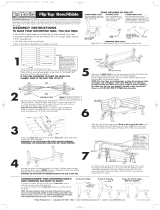Kreg Foreman Pocket-Hole Machine Manuel utilisateur
- Catégorie
- Outils électroportatifs
- Taper
- Manuel utilisateur
La page est en cours de chargement...
La page est en cours de chargement...
La page est en cours de chargement...
La page est en cours de chargement...
La page est en cours de chargement...
La page est en cours de chargement...
La page est en cours de chargement...
La page est en cours de chargement...
La page est en cours de chargement...
La page est en cours de chargement...
La page est en cours de chargement...
La page est en cours de chargement...
La page est en cours de chargement...
La page est en cours de chargement...
La page est en cours de chargement...

Sécurité
!
!
!
AVERTISSEMENT! Cet article contient un ou plusieurs produits
chimiques reconnus par l’État de la Californie comme étant la cause de cancers,
d’anomalies congénitales ou d’autres problèmes liés aux fonctions reproductrices.
Lavez-vous les mains après avoir manipulé l’article.
Règles de sécurité générales
AVERTISSEMENT! Pour votre sécurité, lisez le guide d’utilisation avant
de faire fonctionner cet appareil pour perçage en angle.
AVERTISSEMENT! Lisez toutes les instructions. Le non-respect
des instructions présentées ci-dessous pourrait entraîner un choc électrique, un
incendie ou des blessures graves. L’expression « outil électrique » utilisée dans
tous les avertissements qui gurent ci-dessous désigne les outils électriques
alimentés sur secteur (à l) ou alimentés par piles (sans l).
CONSERVEZ CES INSTRUCTIONS
1) Mesures de sécurité dans l’aire de travail
a) L’airedetravaildoitêtrepropreetbienéclairée. Une aire de
travail encombrée ou peu éclairée augmente le risque d’accident.
b) N’utilisezpasunoutilélectriquedansunenvironnement
dangereux. N’utilisez pas un outil électrique dans un endroit mouillé
ou humide et ne l’exposez pas à la pluie.
c) N’utilisezpasd’outilsélectriquesdansuneatmosphère
explosive,parexempleenprésencedeliquides,devapeursou
depoussièresinammables. Les outils électriques produisent des
étincelles susceptibles d’enammer ces poussières ou ces vapeurs.
d) Gardezlesenfantsetlesautrespersonnesàl’écartlorsque
vousutilisezunoutilélectrique.Une distraction peut vous faire
perdre la maîtrise de l’outil.
e) Empêchez les enfants d’accéder à l’atelier en utilisant des
cadenas et un interrupteur général ou en retirant les clés du
commutateur d’allumage.
2) Consignes de sécurité relatives à l’électricité
a) N’exposezpaslesoutilsélectriquesàlapluieouàtoutautre
environnement humide. Les risques de choc électrique
sont plus élevés si de l’eau s’inltre dans un outil électrique.
b) N’utilisezpaslecordond’alimentationdefaçonabusive.
Netransportezjamaisunoutilélectriqueenletenantparson
cordon,etnetirezjamaissurlecordonpourledébrancher.
Tenez le cordon éloigné des sources de chaleur,
del’huile,desobjetscoupantsetdespiècesmobiles.
Les risques de choc électrique sont plus élevés si le cordon
d’alimentation est endommagé ou emmêlé.
c) Utilisezunerallongeappropriéeetassurez-vousqu’elleest
enbonétat. Utilisez une rallonge dont le calibre convient
au courant consommé par l’outil. Une rallonge de calibre insufsant
causera une baisse de la tension secteur et une perte de puissance
qui occasionneront une surchauffe de l’outil. Letableau1 à la page
suivante indique le calibre à utiliser en fonction de la longueur
de la rallonge et de l’intensité nominale inscrite sur la plaque
signalétique. En cas de doute, utilisez une rallonge de calibre supérieur.
Plus le numéro du calibre est bas, plus la rallonge est résistante.
3) Sécurité personnelle
a) Soyezvigilant,prêtezattentionàcequevousfaitesetfaites
preuvedebonsenslorsquevousutilisezunoutilélectrique.
N’utilisezpasunoutilélectrique lorsquevousêtesfatiguéou
sous l’effet de drogues, d’alcool ou de médicaments.
Un moment d’inattention pendant que vous utilisez des outils
électriques peut occasionner des blessures graves.
b) Portez toujours des lunettes de sécurité. Les lunettes
ordinaires sont seulement munies de verres résistants aux chocs et
ne peuvent PAS être considérées comme des lunettes de sécurité.
c) Utilisezdel’équipementdesécurité. Portez un masque facial
ou un masque anti-poussières si la coupe produit beaucoup de
poussière. Le port d’équipement de sécurité, comme un masque
anti-poussières,des chaussures de sécurité antidérapantes, un
casque de protection et des protecteurs auditifs, lorsque les
conditions l’exigent, réduit les risques de blessures.
d) Évitez les mises en marche accidentelles de l’outil.
Assurez-vousquel’interrupteurdel’outilestàlapositiond’arrêt
avantdelebrancher. Transporter les outils électriques avec le doigt
sur l’interrupteur ou lorsqu’ils sont branchés et sous tension
augmente les risques d’accident.
e) Retireztouteslesclésderéglagedel’outilélectriqueavant
de mettre celui-ci en marche. Une clé de réglage oubliée sur un
élément rotatif peut occasionner des blessures graves.
f) Ne vous étirez pas pour étendre votre portée. Gardez une
posturesécuritaireetunbonéquilibreentouttemps.Vous
pourrez ainsi mieux maîtriser l’outil électrique lorsque des situations i
nattendues se présentent.
g) Fixezbienlapièceàtravailler. Utilisez des colliers de serrage
ou un étau pour xer le matériau sur lequel vous travaillez, au besoin.
Cette technique est plus sécuritaire que l’utilisation de vos mains et
vous gardez ainsi vos mains libres pour faire fonctionner l’outil.
h)Nevoustenezjamaisdeboutsurl’outil. Des blessures graves
peuvent survenir si l’outil se renverse ou s’il y a contact accidentel
avec des bords tranchants.
i) Habillez-vousconvenablement.Neportezpasdevêtements
amplesnidebijoux.Gardezvoscheveux,vosvêtementsetvos
gantsloindespiècesmobiles. Les vêtements amples, les bijoux et
les cheveux longs risquent de se prendre dans les pièces mobiles.
j) Si un dispositif permet de raccorder un dépoussiéreur,
assurez-vousquecelui-ciestbranchéetutilisécorrectement.
L’emploi d’un dépoussiéreur contribue à réduire les dangers liés à la
poussière.
4) Utilisationetentretiend’unoutilélectrique
a) Gardez tous les protecteurs en place et fonctionnels.
b) Neforcezpasl’outilélectrique.Utilisezl’outilélectrique
appropriéàlatâchequevousenvisagez. L’utilisation de l’outil
électrique approprié permet d’obtenir de meilleurs résultats,
de façon plus sécuritaire, selon le régime de fonctionnement prévu.
c) Utilisezlebonoutil. Ne tentez pas d’utiliser un outil ou l’un de
ses accessoires pour effectuer un travail pour lequel il n’est pas conçu.
d) N’utilisezpasl’outilélectriquesil’interrupteurnefonctionnepas.
Un outil électrique qui ne peut pas être contrôlé par l’interrupteur
est dangereux et doit être réparé.
e) Débranchezlachedelapriseouretirezlebloc-pilesde
l’outilélectriqueavantd’effectuerdesréglages,dechanger
d’accessoire ou de ranger l’outil. De telles mesures de sécurité
préventives réduisent les risques de mise en marche accidentelle de
l’outil électrique.
f) Ne laissez jamais l’outil en marche sans supervision. Coupez
l’alimentationélectrique. Ne vous éloignez pas de l’outil tant qu’il
ne s’est pas complètement arrêté.
g) Rangezlesoutilsélectriquesinutiliséshorsdelaportéedes
enfants et ne laissez pas les personnes ne connaissant pas
bienl’outiloucesinstructionsutiliserl’outil. Les outils
électriques sont dangereux s’ils se retrouvent entre les mains
d’utilisateurs qui ne savent pas s’en servir.
h) Entretenezlesoutilsélectriques.Vériezlespiècespourvous
assurerqu’ellesnesontpasdésalignées,enrayées,brisées,ou
dans un état pouvant nuire à leur fonctionnement. Si elles sont
endommagées, faites-les réparer avant d’utiliser l’outil. De
nombreux accidents sont provoqués par des outils mal entretenus.
i) Gardez vos outils tranchants affûtés et propres. Des outils
tranchants bien entretenus et dont les lames sont affûtées risquent
moins de se bloquer et sont plus faciles à maîtriser.
j) Utilisez la vitesse recommandée pour l’outil de coupe,
l’accessoire et la pièce à travailler.
k) N’utilisezquedespiècesetdesaccessoiresrecommandés
parlefabricant. Consultez la liste des accessoires recommandés
dans le guide d’utilisation. L’utilisation d’accessoires inappropriés
peut causer des blessures.
l) Utilisezl’outilélectrique,lesaccessoires,lesembouts,etc.,
conformémentauxinstructionsetauxnspourlesquelles
l’outil a été conçu, en tenant compte des conditions de travail et
des tâches à effectuer. L’utilisation de l’outil électrique à des ns
autres que celles auxquelles il est destiné pourrait entraîner
une situation dangereuse.
5) Entretien
a) Demandezàuntechnicienqualiéd’effectuerl’entretien
devotreoutilélectriqueenutilisantseulementdespiècesde
rechangeidentiquesauxpiècesd’origine. Vous vous assurerez
ainsi de respecter les consignes de sécurité de l’outil électrique.

Sécurité
6) RèglesdesécuritésupplémentairesduForemanDB210
a) Anderéduirelesrisquesdechocélectrique,cetappareilest
munid’unechepolarisée(unelameestpluslargequel’autre).
Cettechenepeutêtrebranchéesuruneprisepolariséeque
dans un sens. Si la che ne peut être branchée sur la prise, essayez
dans l’autre sens. Si elle ne s’insère toujours pas, faites appel à
un électricien qualié pour installer une prise appropriée. Ne modiez la
prise d’aucune façon.
b)Manipulezlesguides-foretsavecprécautionetgardezlesmains
éloignées des guides-forets installés sur une machine. Le jeu minimal
nécessaire entre le foret et le guide-foret utilisé pour améliorer la qualité du
trou présente un bord tranchant pouvant constituer un risque de lacération.
c) Gardezvosmainsloindelamècheetduserre-jointlorsque
vous utilisez la machine.
d) Assurez-vousqueleforetestcomplètementretirédelapièce
àtravailleretqu’ilestcomplètementarrêtéavantderéglerla
position de la pièce.
e) Fixezl’outilenplaceandeprévenirlesbasculementsetles
glissements. Ne vous tenez jamais debout sur l’outil.
f) Suiveztouteslesconsignesd’entretienetdelubrication
détaillées dans le manuel d’instructions.
g) Cet appareil est conçu pour une utilisation précise. Ne le
modiezpasetnel’utilisezpasàd’autresns. Pour toute question
en ce qui a trait à l’utilisation, communiquez avec Kreg Tool Company
an d’obtenir de l’aide AVANT d’utiliser l’outil.
7) Lessymbolessuivantspeuventgurersurl’étiquettedevotreoutil.
Les symboles et leurs dénitions sont les suivants :
CaractéristiquesdumoteurduForemanDB210
120 V~5 A, 2800 tours/minute
Directives liées aux rallonges
Les rallonges ne servent qu’à un usage temporaire. Elles ne remplacent pas la
nécessité d’installer des prises et d’effectuer le câblage, au besoin.
Dans l’atelier ou sur les chantiers de construction :
1. Utilisez des rallonges munies d’un conducteur de mise à la terre en tout
temps.
2. Protégez les rallonges contre les dommages. Ne les faites pas passer
par les portes ou les fenêtres, car celles-ci pourraient se refermer et
endommager les rallonges.
3. Choisissez des rallonges d’un calibre minimal de 16 AWG qui
conviennent aux outils que vous utilisez.
4. Inspectez périodiquement les rallonges an de vous assurer que les ls
sont bien isolés et que leur conductivité n’est pas compromise.
5. Ne faites pas passer de rallonges dans l’eau et ne les raccordez pas
dans des endroits où de l’eau pourrait s’accumuler.
Calibre de la
rallonge
Longueur de la rallonge
Plaque signalétique :
ampères à 120 V
7,62 m 15,24 m 22,86 m 30,48 m 45,72 m 60,96 m
0 à 5 16 16 16 14 12 12
5,1 à 8 16 16 14 12 10 NR
8,1 à 12 14 14 12 10 NR NR
12,1 à 16 12 12 NR NR NR NR
NR : non recommandé
TABLEAU1
symboled’alertedesécurité
volts
hertz
ampères
watts
courant continu
courant alternatif
courant alternatif ou continu
appareildeclasseI(misàlaterre)
appareildeclasseII(doubleisolation)
bornedemiseàlaterre
minutes
par minute
battementsparminute
tours par minute
vitesse sans charge
V
Hz
A
W
min
/min
BPM
RPM
!
English
3
• Be sure that the cutter knives are mounted as described in the
instruction manual and check that all bolts are firmly tightened
before connecting unit to power source.
• To avoid injury, never rotate the cutter block directly with your
hands.
• Keep guards in place and in good working order.
• Stay alert – never operate the unit when tired or under the
influence of drugs, alcohol, or medication.
• Do not use in dangerous environments. Do not use near
flammable substances, in damp or wet locations, or expose to
rain.
• Never plane material which is shorter than 12 inches.
• Exhaust chute: remove shavings with brush or vacuum after
power has been shut off and cutter head has stopped rotating.
• ALWAYS LOCATE PLANER WITH PROPER CLEARANCE ON
THE OUTFEED SIDE of the unit to prevent pinching or binding of
the workpiece against any obstacle.
• Clean out your tool often, especially after heavy use. Dust
and grit containing metal particles often accumulate on interior
surfaces and could create a risk of serious injury, electric shock or
electrocution. ALWAYS WEAR SAFETY GLASSES.
WARNING: For your own safety, it is recommended that two
people carry this machine or serious injury could result.
WARNING: Always wear proper personal hearing protection
that conforms to ANSI S12.6 (S3.19) during use. Under some
conditions and duration of use, noise from this product may
contribute to hearing loss.
WARNING: Some dust created by power sanding, sawing,
grinding, drilling, and other construction activities contains chemicals
known to the State of California to cause cancer, birth defects or
other reproductive harm. Some examples of these chemicals are:
• lead from lead-based paints,
• crystalline silica from bricks and cement and other masonry
products, and
• arsenic and chromium from chemically-treated lumber.
Your risk from these exposures varies, depending on how often you
do this type of work. To reduce your exposure to these chemicals:
work in a well ventilated area, and work with approved safety
equipment, such as those dust masks that are specially designed to
filter out microscopic particles.
• Avoid prolonged contact with dust from power sanding,
sawing, grinding, drilling, and other construction activities.
Wear protective clothing and wash exposed areas with
soap and water. Allowing dust to get into your mouth, eyes, or
lay on the skin may promote absorption of harmful chemicals.
WARNING: A dust mask or respirator should be worn by all
persons entering the work area. The filter should be replaced daily or
whenever the wearer has difficulty breathing. See your local hardware
store for the proper NIOSH/OSHA approved dust mask.
• The label on your tool may include the following symbols. The
symbols and their definitions are as follows:
V ......... volts A .......amperes
Hz ....... hertz W ......watts
min ..... minutes
.....alternating current
... direct current .....alternating or direct current
....... Class I Construction
n
o ......no load speed
........... (grounded)
......earthing terminal
....... Class II Construction .....safety alert symbol
........... (double insulated) BPM ..beats per minute
…/min per minute RPM ..revolutions per minute
English
3
• Be sure that the cutter knives are mounted as described in the
instruction manual and check that all bolts are firmly tightened
before connecting unit to power source.
• To avoid injury, never rotate the cutter block directly with your
hands.
• Keep guards in place and in good working order.
• Stay alert – never operate the unit when tired or under the
influence of drugs, alcohol, or medication.
• Do not use in dangerous environments. Do not use near
flammable substances, in damp or wet locations, or expose to
rain.
• Never plane material which is shorter than 12 inches.
• Exhaust chute: remove shavings with brush or vacuum after
power has been shut off and cutter head has stopped rotating.
• ALWAYS LOCATE PLANER WITH PROPER CLEARANCE ON
THE OUTFEED SIDE of the unit to prevent pinching or binding of
the workpiece against any obstacle.
• Clean out your tool often, especially after heavy use. Dust
and grit containing metal particles often accumulate on interior
surfaces and could create a risk of serious injury, electric shock or
electrocution. ALWAYS WEAR SAFETY GLASSES.
WARNING: For your own safety, it is recommended that two
people carry this machine or serious injury could result.
WARNING: Always wear proper personal hearing protection
that conforms to ANSI S12.6 (S3.19) during use. Under some
conditions and duration of use, noise from this product may
contribute to hearing loss.
WARNING: Some dust created by power sanding, sawing,
grinding, drilling, and other construction activities contains chemicals
known to the State of California to cause cancer, birth defects or
other reproductive harm. Some examples of these chemicals are:
• lead from lead-based paints,
• crystalline silica from bricks and cement and other masonry
products, and
• arsenic and chromium from chemically-treated lumber.
Your risk from these exposures varies, depending on how often you
do this type of work. To reduce your exposure to these chemicals:
work in a well ventilated area, and work with approved safety
equipment, such as those dust masks that are specially designed to
filter out microscopic particles.
• Avoid prolonged contact with dust from power sanding,
sawing, grinding, drilling, and other construction activities.
Wear protective clothing and wash exposed areas with
soap and water. Allowing dust to get into your mouth, eyes, or
lay on the skin may promote absorption of harmful chemicals.
WARNING: A dust mask or respirator should be worn by all
persons entering the work area. The filter should be replaced daily or
whenever the wearer has difficulty breathing. See your local hardware
store for the proper NIOSH/OSHA approved dust mask.
• The label on your tool may include the following symbols. The
symbols and their definitions are as follows:
V ......... volts A .......amperes
Hz ....... hertz W ......watts
min ..... minutes
.....alternating current
... direct current .....alternating or direct current
....... Class I Construction
n
o ......no load speed
........... (grounded)
......earthing terminal
....... Class II Construction .....safety alert symbol
........... (double insulated) BPM ..beats per minute
…/min per minute RPM ..revolutions per minute
English
3
• Be sure that the cutter knives are mounted as described in the
instruction manual and check that all bolts are firmly tightened
before connecting unit to power source.
• To avoid injury, never rotate the cutter block directly with your
hands.
• Keep guards in place and in good working order.
• Stay alert – never operate the unit when tired or under the
influence of drugs, alcohol, or medication.
• Do not use in dangerous environments. Do not use near
flammable substances, in damp or wet locations, or expose to
rain.
• Never plane material which is shorter than 12 inches.
• Exhaust chute: remove shavings with brush or vacuum after
power has been shut off and cutter head has stopped rotating.
• ALWAYS LOCATE PLANER WITH PROPER CLEARANCE ON
THE OUTFEED SIDE of the unit to prevent pinching or binding of
the workpiece against any obstacle.
• Clean out your tool often, especially after heavy use. Dust
and grit containing metal particles often accumulate on interior
surfaces and could create a risk of serious injury, electric shock or
electrocution. ALWAYS WEAR SAFETY GLASSES.
WARNING: For your own safety, it is recommended that two
people carry this machine or serious injury could result.
WARNING: Always wear proper personal hearing protection
that conforms to ANSI S12.6 (S3.19) during use. Under some
conditions and duration of use, noise from this product may
contribute to hearing loss.
WARNING: Some dust created by power sanding, sawing,
grinding, drilling, and other construction activities contains chemicals
known to the State of California to cause cancer, birth defects or
other reproductive harm. Some examples of these chemicals are:
• lead from lead-based paints,
• crystalline silica from bricks and cement and other masonry
products, and
• arsenic and chromium from chemically-treated lumber.
Your risk from these exposures varies, depending on how often you
do this type of work. To reduce your exposure to these chemicals:
work in a well ventilated area, and work with approved safety
equipment, such as those dust masks that are specially designed to
filter out microscopic particles.
• Avoid prolonged contact with dust from power sanding,
sawing, grinding, drilling, and other construction activities.
Wear protective clothing and wash exposed areas with
soap and water. Allowing dust to get into your mouth, eyes, or
lay on the skin may promote absorption of harmful chemicals.
WARNING: A dust mask or respirator should be worn by all
persons entering the work area. The filter should be replaced daily or
whenever the wearer has difficulty breathing. See your local hardware
store for the proper NIOSH/OSHA approved dust mask.
• The label on your tool may include the following symbols. The
symbols and their definitions are as follows:
V ......... volts A .......amperes
Hz ....... hertz W ......watts
min ..... minutes
.....alternating current
... direct current .....alternating or direct current
....... Class I Construction
n
o ......no load speed
........... (grounded)
......earthing terminal
....... Class II Construction .....safety alert symbol
........... (double insulated) BPM ..beats per minute
…/min per minute RPM ..revolutions per minute
English
3
• Be sure that the cutter knives are mounted as described in the
instruction manual and check that all bolts are firmly tightened
before connecting unit to power source.
• To avoid injury, never rotate the cutter block directly with your
hands.
• Keep guards in place and in good working order.
• Stay alert – never operate the unit when tired or under the
influence of drugs, alcohol, or medication.
• Do not use in dangerous environments. Do not use near
flammable substances, in damp or wet locations, or expose to
rain.
• Never plane material which is shorter than 12 inches.
• Exhaust chute: remove shavings with brush or vacuum after
power has been shut off and cutter head has stopped rotating.
• ALWAYS LOCATE PLANER WITH PROPER CLEARANCE ON
THE OUTFEED SIDE of the unit to prevent pinching or binding of
the workpiece against any obstacle.
• Clean out your tool often, especially after heavy use. Dust
and grit containing metal particles often accumulate on interior
surfaces and could create a risk of serious injury, electric shock or
electrocution. ALWAYS WEAR SAFETY GLASSES.
WARNING: For your own safety, it is recommended that two
people carry this machine or serious injury could result.
WARNING: Always wear proper personal hearing protection
that conforms to ANSI S12.6 (S3.19) during use. Under some
conditions and duration of use, noise from this product may
contribute to hearing loss.
WARNING: Some dust created by power sanding, sawing,
grinding, drilling, and other construction activities contains chemicals
known to the State of California to cause cancer, birth defects or
other reproductive harm. Some examples of these chemicals are:
• lead from lead-based paints,
• crystalline silica from bricks and cement and other masonry
products, and
• arsenic and chromium from chemically-treated lumber.
Your risk from these exposures varies, depending on how often you
do this type of work. To reduce your exposure to these chemicals:
work in a well ventilated area, and work with approved safety
equipment, such as those dust masks that are specially designed to
filter out microscopic particles.
• Avoid prolonged contact with dust from power sanding,
sawing, grinding, drilling, and other construction activities.
Wear protective clothing and wash exposed areas with
soap and water. Allowing dust to get into your mouth, eyes, or
lay on the skin may promote absorption of harmful chemicals.
WARNING: A dust mask or respirator should be worn by all
persons entering the work area. The filter should be replaced daily or
whenever the wearer has difficulty breathing. See your local hardware
store for the proper NIOSH/OSHA approved dust mask.
• The label on your tool may include the following symbols. The
symbols and their definitions are as follows:
V ......... volts A .......amperes
Hz ....... hertz W ......watts
min ..... minutes
.....alternating current
... direct current .....alternating or direct current
....... Class I Construction
n
o ......no load speed
........... (grounded)
......earthing terminal
....... Class II Construction .....safety alert symbol
........... (double insulated) BPM ..beats per minute
…/min per minute RPM ..revolutions per minute
English
3
• Be sure that the cutter knives are mounted as described in the
instruction manual and check that all bolts are firmly tightened
before connecting unit to power source.
• To avoid injury, never rotate the cutter block directly with your
hands.
• Keep guards in place and in good working order.
• Stay alert – never operate the unit when tired or under the
influence of drugs, alcohol, or medication.
• Do not use in dangerous environments. Do not use near
flammable substances, in damp or wet locations, or expose to
rain.
• Never plane material which is shorter than 12 inches.
• Exhaust chute: remove shavings with brush or vacuum after
power has been shut off and cutter head has stopped rotating.
• ALWAYS LOCATE PLANER WITH PROPER CLEARANCE ON
THE OUTFEED SIDE of the unit to prevent pinching or binding of
the workpiece against any obstacle.
• Clean out your tool often, especially after heavy use. Dust
and grit containing metal particles often accumulate on interior
surfaces and could create a risk of serious injury, electric shock or
electrocution. ALWAYS WEAR SAFETY GLASSES.
WARNING: For your own safety, it is recommended that two
people carry this machine or serious injury could result.
WARNING: Always wear proper personal hearing protection
that conforms to ANSI S12.6 (S3.19) during use. Under some
conditions and duration of use, noise from this product may
contribute to hearing loss.
WARNING: Some dust created by power sanding, sawing,
grinding, drilling, and other construction activities contains chemicals
known to the State of California to cause cancer, birth defects or
other reproductive harm. Some examples of these chemicals are:
• lead from lead-based paints,
• crystalline silica from bricks and cement and other masonry
products, and
• arsenic and chromium from chemically-treated lumber.
Your risk from these exposures varies, depending on how often you
do this type of work. To reduce your exposure to these chemicals:
work in a well ventilated area, and work with approved safety
equipment, such as those dust masks that are specially designed to
filter out microscopic particles.
• Avoid prolonged contact with dust from power sanding,
sawing, grinding, drilling, and other construction activities.
Wear protective clothing and wash exposed areas with
soap and water. Allowing dust to get into your mouth, eyes, or
lay on the skin may promote absorption of harmful chemicals.
WARNING: A dust mask or respirator should be worn by all
persons entering the work area. The filter should be replaced daily or
whenever the wearer has difficulty breathing. See your local hardware
store for the proper NIOSH/OSHA approved dust mask.
• The label on your tool may include the following symbols. The
symbols and their definitions are as follows:
V ......... volts A .......amperes
Hz ....... hertz W ......watts
min ..... minutes
.....alternating current
... direct current .....alternating or direct current
....... Class I Construction
n
o ......no load speed
........... (grounded)
......earthing terminal
....... Class II Construction .....safety alert symbol
........... (double insulated) BPM ..beats per minute
…/min per minute RPM ..revolutions per minute
English
3
• Be sure that the cutter knives are mounted as described in the
instruction manual and check that all bolts are firmly tightened
before connecting unit to power source.
• To avoid injury, never rotate the cutter block directly with your
hands.
• Keep guards in place and in good working order.
• Stay alert – never operate the unit when tired or under the
influence of drugs, alcohol, or medication.
• Do not use in dangerous environments. Do not use near
flammable substances, in damp or wet locations, or expose to
rain.
• Never plane material which is shorter than 12 inches.
• Exhaust chute: remove shavings with brush or vacuum after
power has been shut off and cutter head has stopped rotating.
• ALWAYS LOCATE PLANER WITH PROPER CLEARANCE ON
THE OUTFEED SIDE of the unit to prevent pinching or binding of
the workpiece against any obstacle.
• Clean out your tool often, especially after heavy use. Dust
and grit containing metal particles often accumulate on interior
surfaces and could create a risk of serious injury, electric shock or
electrocution. ALWAYS WEAR SAFETY GLASSES.
WARNING: For your own safety, it is recommended that two
people carry this machine or serious injury could result.
WARNING: Always wear proper personal hearing protection
that conforms to ANSI S12.6 (S3.19) during use. Under some
conditions and duration of use, noise from this product may
contribute to hearing loss.
WARNING: Some dust created by power sanding, sawing,
grinding, drilling, and other construction activities contains chemicals
known to the State of California to cause cancer, birth defects or
other reproductive harm. Some examples of these chemicals are:
• lead from lead-based paints,
• crystalline silica from bricks and cement and other masonry
products, and
• arsenic and chromium from chemically-treated lumber.
Your risk from these exposures varies, depending on how often you
do this type of work. To reduce your exposure to these chemicals:
work in a well ventilated area, and work with approved safety
equipment, such as those dust masks that are specially designed to
filter out microscopic particles.
• Avoid prolonged contact with dust from power sanding,
sawing, grinding, drilling, and other construction activities.
Wear protective clothing and wash exposed areas with
soap and water. Allowing dust to get into your mouth, eyes, or
lay on the skin may promote absorption of harmful chemicals.
WARNING: A dust mask or respirator should be worn by all
persons entering the work area. The filter should be replaced daily or
whenever the wearer has difficulty breathing. See your local hardware
store for the proper NIOSH/OSHA approved dust mask.
• The label on your tool may include the following symbols. The
symbols and their definitions are as follows:
V ......... volts A .......amperes
Hz ....... hertz W ......watts
min ..... minutes
.....alternating current
... direct current .....alternating or direct current
....... Class I Construction
n
o ......no load speed
........... (grounded)
......earthing terminal
....... Class II Construction .....safety alert symbol
........... (double insulated) BPM ..beats per minute
…/min per minute RPM ..revolutions per minute
Avertissement :
!
Cet article peut vous exposer à des produits chimiques,
notamment au plomb, une substance reconnue par l’État de la Californie comme
étant la cause de cancers, d’anomalies congénitales ou de problèmes liés aux
fonctions reproductrices. Pour plus de renseignements, rendez-vous au
www.P65Warnings.ca.gov.
Avertissement :
!
et article peut vous exposer à des produits chimiques,
notamment au plomb et à d’autres produits reconnus par l’État de la Californie
comme étant la cause de cancers, d’anomalies congénitales et d’autres problèmes
liés aux fonctions reproductrices. Pour plus de renseignements,
rendez-vous au www.P65Warnings.ca.gov.
Avertissement :
!
Le perçage, le sciage, le ponçage et l’usinage des produits
en bois peuvent vous exposer à de la poussière de bois, une substance reconnue
par l’État de la Californie comme étant la cause de cancers. Évitez d’inhaler la
poussière de bois ou utilisez un masque antipoussières ou d’autres mesures de
sécurité pour vous protéger. Pour plus de renseignements,
rendez-vous au www.P65Warnings.ca.gov/wood.

Introduction
Item# Description
Pièces
1
8
7
6
5
4
3
2
9
10
11
12
13
14
15
16
17
Bras de commande
Verrou du bras de commande
Base de l’outil
Poignées
Conduit d’aspiration
Vis autotaraudeuses
Collecteur d’aspiration
Vis à métaux à tête bombée
Colliers de serrage
Tuyau d’aspiration
Panneau d’accès
Dessus de l’outil
Clé hexagonale de 3 mm
Dispositifs de nivellement du couvercle
Leviers de blocage du guide d’un quart de tour
Guide
Vis de blocage du guide
Bases des vis de blocage du guide
Marques indiquant l’épaisseur de la pièce à travailler
Foret
Bouton de blocage de la profondeur de perçage
Bloc d’appui de la profondeur de perçage
Guide-foret (guide standard inclus)
Contre-écrou de la butée de profondeur
Boîtier du bras du serre-joint
Tampon du serre-joint
Bouton de réglage du serre-joint
Contre écrou du serre-joint
Bras du serre-joint
Bouton du verrou de sécurité de l’interrupteur
Interrupteur
Butées de pièce à travailler
Ruban à mesurer à lecture centrale
Embout de tournevis carré nº 2 de 6 po
Plateau à accessoires
Pied
Trou de montage
Support du panneau
Goupille de déverrouillage
Moteur
Tiges de guidage
Mandrin à changement rapide
Tige de raccord du moteur
Pivots
Logements des pivots
Vis de calage du guide-foret
18
Item# Description
20
19
28
31
38
37
36
35
34
33
32
39
21
22
23
24
25
26
27
29
Félicitations pour votre achat de l’outil pour perçage en angle semi-automatique Foreman DB210 de Kreg. Avant d’utiliser cet article, lisez
toutes les instructions et les consignes de sécurités contenues dans le présent manuel.
Lorsque vous possédez un outil Foreman, vous protez de tous les avantages d’un véritable outil pour perçage en angle industriel, ainsi que
de la petite taille et de la portabilité d’un outil d’établi. Le présent manuel vous guidera à travers toutes les étapes nécessaires pour régler
votre outil et percer des trous en angle. En plus de celles contenues dans ce manuel, les ressources suivantes pourraient vous être utiles :
30
40
41
42
43
44
45
Kreg en ligne : pour commander des vis pour perçage en angle, voir les accessoires oerts pour votre gabarit ou savoir
comment faire un joint en particulier, visitez le site kregtool.com.
Communauté des propriétaires de Kreg : inscrivez-vous en tant que membre, créez votre propre page, regardez les
projets des autres membres, achez les photos de vos projets, visionnez des vidéos d’instructions et participez à des forums
en vous rendant au kregjig.ning.com.
Chaîne YouTube de Kreg : pour des projets, des produits et des vidéos d’instructions, visitez le site youtube.com/user/
kregtoolcompany.
Kreg sur Facebook : prenez contact avec Kreg sur Facebook an de partager vos projets et de vous inspirer de nos
admirateurs et amis sur facebook.com/kregJig.
46

Pièces
10
6
5
7
4
32
32
36
37
11
4
15
25
31
30
1
33
16
15
29
28
27
9
22
34
13
8
12
26
23
21
17
17
3

Pièces
4
2
24
15
21
25
15
19
3
40
4
35
39
38
14
43
46
14
23
41
20

Assemblage
Poussez le bras de commande (1) vers le bas, déverrouillez le
verrou du bras de commande (2) situé à l’arrière de la base de l’outil
(3), puis soulevez complètement le bras de commande jusqu’à la
position verticale. Ne laissez pas le bras s’enclencher entièrement en
position verticale. Pour transporter et ranger l’outil, poussez le bras de
commande vers le bas et enclenchez le verrou du bras de commande.
Déverrouillage du bras de commande
Installation du système de nettoyage des copeaux
9
8
7
6
10
5
7
9
Débranchez toujours l’outil avant de l’assembler, d’ouvrir le
couvercle d’accès ou d’eectuer des réglages.
Ne soulevez ni ne transportez jamais l’outil en le tenant par le bras
de commande. Utilisez toujours les poignées (4) situées à l’avant et
à l’arrière de l’outil.
Le panneau d’accès devrait être de niveau avec le dessus de l’outil
lorsque vous le sortez de la boîte. Si vous devez eectuer des
réglages, suivez la procédure suivante :
Placez l’outil sur des chevalets de sciage an d’avoir accès au dessous.
Placez une pièce droite sur le dessus de l’outil (12) et le panneau
d’accès (11). Utilisez la clé hexagonale de 3 mm (13) fournie avec l’outil
an de tourner les dispositifs de nivellement du couvercle (14).
Nivellement du panneau d’accès
11
12
Enclencher
Déverrouiller
2
14
13
4
14
Le Foreman est oert avec un système de nettoyage des copeaux qui
comprend un orice d’aspiration de 6,99 cm (5), des vis autotaraudeuses
(6), un collecteur d’aspiration (7), des vis à métaux (8), des colliers de
serrage (9) et un tuyau d’aspiration (10). En plus d’aider à garder votre
aire de travail propre, enlever les copeaux vous permet de percer plus
rapidement et de réduire la chaleur, prolongeant ainsi la durée de vie
de votre foret. Un appareil Foreman muni du système de nettoyage des
copeaux doit être raccordé à un aspirateur d’atelier lorsque vous l’utilisez.
Si vous ne raccordez pas le système de nettoyage des copeaux à un
aspirateur d’atelier, les copeaux s’accumuleront dans le tuyau et dans
le collecteur d’aspiration, ce qui nira par obstruer le foret. Vous pouvez
utiliser le Foreman sans avoir installé le système de nettoyage des
copeaux. Si vous installez le système et désirez utiliser votre appareil
Foreman sans le raccorder à un aspirateur d’atelier, vous n’avez qu’à
retirer le tuyau d’aspiration du collecteur.
Pour installer le système de nettoyage des copeaux, couchez le Foreman
sur le côté. À partir de l’intérieur de la base de l’outil (3), insérez le conduit
d’aspiration (5) dans le trou situé à l’arrière de la base. Fixez-le de
l’extérieur à l’aide de deux vis autotaraudeuses (6). Vissez le collecteur
d’aspiration (7) à l’outil à l’aide de quatre vis à métaux à tête bombée (8).
Glissez les colliers de serrage (9) sur les extrémités du tuyau d’aspiration
(10), puis insérez les extrémités de ce dernier dans le conduit d’aspiration
et le collecteur. Pour retirer facilement le tuyau d’aspiration du collecteur
à partir du panneau d’accès (11), placez le collier de serrage avant de
manière à ce que la tête de la vis soit orientée vers l’avant de l’outil. Serrez
les colliers de serrage et remettez le Foreman à l’endroit.
Avertissement :
!
Manipulez les guides-forets avec précaution et gardez les mains
éloignées des guides-forets installés sur une machine. Le jeu minimal nécessaire entre le foret
et le guide-foret utilisé pour améliorer la qualité du trou présente un bord tranchant pouvant
constituer un risque de lacération.

Assemblage
Tournez les leviers de blocage du guide d’un quart de tour (15) dans
le sens des aiguilles d’une montre (verrouillage). Si le guide (16) peut
être bougé en appliquant une pression modérée, serrez les vis de
blocage du guide (17). Tournez les leviers dans le sens contraire des
aiguilles d’une montre (déverrouillage) et assurez-vous que le guide
bouge librement.
S’il est nécessaire de démonter le dispositif de blocage du guide,
orientez la section plate des bases des vis de blocage du guide (18)
vers le guide, tel que l’illustre le schéma.
Réglage de la pression du dispositif de verrouillage
du guide
16
17
Pour un joint solide, la vis pour perçage en angle devrait
sortir au centre de la pièce à travailler. Pour ce faire, ajustez la
position du guide.
Déverrouillez le guide (16) en tournant les leviers de blocage
du guide (15) dans le sens contraire des aiguilles d’une montre.
Alignez le rebord arrière du guide avec les marqueurs d’épaisseur
de pièce (19) moulés sur le dessus de l’outil (12) qui correspondent
à l’épaisseur de votre pièce. Tournez les leviers dans le sens des
aiguilles d’une montre pour xer le guide en place.
(1) Positionnez le guide en fonction de l’épaisseur
de la pièce
Pour obtenir des joints solides, vous devez régler votre outil de
manière à ce qu’il corresponde à l’épaisseur de votre pièce et à la
longueur de la vis. Le Foreman permet de le faire facilement; en
quatre étapes seulement :
Guide de sélection des vis
Épaisseur du matériau Longueur de la vis
12,7 mm [
1
⁄2 po]*
25,4 mm [1 po]**
15,87 mm [
5
⁄8 po] 25,4 mm [1 po]
19,05 mm [
3
⁄4 po] 31,75 mm [1
1
⁄4 po]
22,22 mm [
7
⁄8 po] 38,1 mm [1
1
⁄2 po]
25,4 mm [1 po] 38,1 mm [1
1
⁄2 po]
28,57 mm [1
1
⁄8 po] 38,1 mm [1
1
⁄2 po]
31,75 mm [1
1
⁄4 po] 50,8 mm [2 po]
34,92 mm [1
3
⁄8 po]
50,8 mm [2 po]
38,1 mm [1
1
⁄2 po]
63,5 mm [2
1
⁄2 po]
* La longueur de la vis est calculée du bas de la tête au
bout de la vis
31,75 mm (1
1
⁄4 po)
Kreg vous ore une gamme complète de vis pour perçage à angle
pour toutes les épaisseurs et tous les types de pièces travaillées.
Utilisez le tableau suivant pour choisir la bonne longueur de vis.
Toutes les vis pour perçage à angle Kreg sont oertes chez votre
détaillant Kreg ou en ligne sur le site www.kregjig.com.
(2) Choisissez une vis
12
19
16
15
15
Fonctionnement
Vis à let n
En raison de leur diamètre et de leur pas de letage plus petits, nos vis à let n nº 7
réduisent les risques de fendre le matériau. Nous recommandons de les utiliser avec
les bois francs.
Vis à let normal
En raison de leur grand diamètre et de leur grand pas de letage, nos vis à let
normal nº 8 offrent une prise solide sur les bois résineux et les matériaux composites
comme le contreplaqué, les panneaux de particules et les MDF.
18
section plate
* L’utilisation d’une vis pour
perçage à angle à tête
cylindrique large est recommandée.
Lors de l’utilisation du guide-foret
Micro-Pocket
™
en option, des vis
de
3
⁄4 po sont recommandées pour
les matériaux de 12,7 mm (
1
⁄2 po)
d’épaisseur. Consultez le guide
d’utilisation de Micro-Pocket

Fonctionnement
Tirez le bras de commande (1) vers le bas, en avançant le foret
(20) jusqu’à ce que le bout touche le guide (16). Au besoin, tournez
le bouton de blocage de profondeur du perçage (21) dans le sens
contraire des aiguilles d’une montre. Ramenez le bras de commande
complètement en position verticale, ce qui rétractera le foret.
Placez le bloc d’appui pour la profondeur du perçage (22) contre
le guide avec les marques de longueur de la vis pointant vers le
haut. Centrez le palier du bloc d’appui correspondant à la longueur
de la vis que vous utiliserez sur le guide-foret (23). Tirez le bras de
commande vers le bas, en insérant l’embout du foret dans le trou
du palier. Avec l’épaulement du foret appuyé contre le palier du bloc
d’appui, tournez le bouton de blocage de profondeur du perçage
(21) dans le sens des aiguilles d’une montre jusqu’à ce qu’il s’arrête.
Serrez le contre-écrou (24) sur la base du boîtier du bras du serre-
joint (25). Ramenez le bras de commande complètement en position
verticale.
Remarque : Lorsque vous verrouillez le bras de commande pour
transporter ou entreposer l’outil, tournez le bouton de blocage de
profondeur dans le sens contraire des aiguilles d’une montre an
que le bras revienne complètement vers le bas.
(3) Dénissez la profondeur de perçage
20
16
21
1
25
22
24
Utilisation du bloc d’appui pour la
profondeur du perçage
Guide-foret et
foret
Épaisseur du
matériau
Longueur de
la vis
Réglage du bloc
d’appui
Micro*
1/2 po 3/4 po 3/4 po
Micro* et
standard
5/8 po à 1 1/8 po
1 po, 1 1/4po,
1 1/2 po
1 po, 1 1/4 po,
1 1/2 po
Standard
1 1/4 po à 1
3/8 po
2 po 2 po
Standard et HD* 1 1/2 po 2 1/2po 2 1/2po
* Accessoires en option
Quand vous utilisez le dispositif de nettoyage des copeaux,
branchez un aspirateur d’atelier sur le conduit d’aspiration (5) et
mettez-le en marche. Maintenez solidement la pièce à travailler
contre le guide (16) en gardant l’emplacement du trou en angle
centré sur le guide-foret (23). Appuyez sur le bouton de verrouillage
de l’interrupteur (30) situé sur le bras de commande (1) puis
sur l’interrupteur (31), ce qui mettra le moteur de la perceuse
en marche. Attendez que le moteur atteigne sa pleine vitesse,
et tirez doucement sur le bras de commande jusqu’à ce qu’il
entre en contact avec la butée de profondeur. Ramenez le bras
de commande complètement en position verticale et relâchez
l’interrupteur.
Perçage des trous en angle
Levez le bras de commande (1) complètement en position verticale.
Placez la pièce travaillée contre le guide (16) et sous le tampon du
serre-joint (26). Tournez le bouton d’ajustement du serre-joint (27)
dans le sens des aiguilles d’une montre jusqu’à ce que le tampon du
serre-joint entre en contact avec la pièce à travailler. Ensuite, tournez
le bouton d’un demi-tour dans le sens contraire des aiguilles d’une
montre. Serrez le contre-écrou (28) contre le bras du serre-joint (29).
Le serre-joint est maintenant placé de façon à ce le fait de baisser
le bras de commande exerce susamment de pression pour xer la
pièce travaillée avant que le foret pénètre dans le bois.
(4) Ajustez le serre-joint
16
1
27
28
26
29
Avertissement :
!
Manipulez les guides-forets avec précaution et gardez les mains
éloignées des guides-forets installés sur une machine. Le jeu minimal nécessaire entre le foret
et le guide-foret utilisé pour améliorer la qualité du trou présente un bord tranchant pouvant
constituer un risque de lacération.

Fonctionnement
En plus de bien régler l’outil, il est important d’espacer les trous
en angle de façon appropriée sur la surface de la pièce à travailler
pour obtenir des joints solides. Pour les pièces étroites comme les
traverses, les montants et les cadres, placez les trous en angle de
3/8 po à 1/2 po de chaque rebord. Les lignes ombrées sur le ruban
à mesurer indiquent ce décalage. Il n’est donc pas nécessaire de
marquer l’emplacement des trous en angle. Alignez simplement le
rebord de votre pièce à la ligne ombrée et percez. Pour les pièces
larges comme les panneaux et les plateaux de table, placez le premier
trou en angle à 2 po de l’extrémité de la pièce et les autres à une
distance de 6 po les uns des autres.
Position des trous en angle
Une butée de pièce peut être utilisée de chaque côté du guide-
foret en la faisant glisser hors de la fente en T du guide, en
l’inversant de manière à ce que le bras de butée soit face au
centre et en la réinstallant dans la fente en T.
Desserrez le boulon à tête creuse de la butée de pièce (32) à
l’aide de la clé hexagonale de 3 mm (13), glissez la butée jusqu’à
l’emplacement désiré et serrez le boulon. Gardez le guide (16)
centré bord à bord, cela vous permet d’utiliser le ruban à mesurer
à lecture centrale (33) pour positionner les butées. Vous pouvez ne
pas utiliser une butée en plaçant la pièce à travailler sur la butée et
en poussant le bras de butée à ressort dans le corps de la butée.
Il est possible de maintenir le bras de butée en position rétractée
en appuyant le bras dans le corps de la butée, puis en le glissant
vers le boulon à tête creuse qui xe la butée au guide. L’encoche
du bras sert de point de saisie. Pour remettre le bras de butée en
fonction, glissez-le dans la direction opposée du boulon.
Butées de pièce à travailler
16
13
33
32

Fonctionnement
Pour éviter toute utilisation non autorisée de l’outil, un trou dans
l’interrupteur (31) vous permet de le verrouiller à la position d’arrêt
avec un cadenas. (non inclus).
Verrou de sécurité
Vous pouvez ranger la clé hexagonale (13), l’embout de tournevis
carré nº 2 (34), les guide-forets et les forets Micro et HD optionnels
dans le plateau à accessoires (35) situé sous le panneau d’accès (11).
Rangement pour accessoires
An de vous orir des options de xation à une surface de
travail, les pieds (36) situés à chaque coin de la base de l’outil
Foreman comprennent une surface plane vous permettant de
xer temporairement l’outil à un établi et un trou de montage (37),
pour une xation permanente. (Vous pouvez insérer des vis pour
perçage à angle Kreg HD nº 14 de 2 1/2 po dans les trous.)
Fixation sécuritaire
36
37
31
35

Fonctionnement
1. Gardez le moteur propre et la base de l’outil exempte de
copeaux et de poussière. Si vous n’utilisez pas un aspirateur
d’atelier, retirez régulièrement les déchets qui se trouvent à
l’intérieur de l’outil, ou xez l’outil sur un support ouvert an
d’éviter l’accumulation de déchets.
2. Lubriez périodiquement les tiges de guidage à l’aide d’un
lubriant à pellicule sèche comme le lubriant Dri-Tool™
d’Empire Manufacturing. Un lubriant à pellicule sèche
empêchera l’accumulation de copeaux de bois et de poussière
et prolongera la durée de vie des roulements et des tiges
de guidage. La tige de raccord du moteur et le dispositif de
raccord du mécanisme de serrage devraient être lubriés
périodiquement an de vous assurer qu’ils bougent sans
problème.
3. Utilisez un foret pointu. Vous pouvez percer entre 4 000
et 5 000 trous dans du chêne avant de devoir aiguiser le
foret. Planiez votre horaire d’aiguisage en fonction de vos
réglages et des matériaux que vous percez. Gardez le foret
propre et exempt de poix, de résine et de colle pour prolonger
considérablement sa durée de vie. Nettoyez périodiquement
le foret à l’aide d’un nettoyant comme le Blade Saver™ et
appliquez un lubriant sec comme l’OptiCut-XL™, tous deux
oerts par Empire Manufacturing. Même si un foret est sale, il
peut être très coupant. Faites toujours preuve de prudence en
manipulant les bords tranchants.
Kreg ore un service d’aûtage pour les forets à
trous en angles standard seulement. Pour plus de
renseignements, communiquez avec notre service à la
clientèle par téléphone au 800 447-8638 ou par courriel à
Suivez les étapes ci-dessous lors du remplacement d’un foret
ou de l’installation des forets et des guide-forets Micro ou HD.
An de protéger les butées de pièce (32), déverrouillez les leviers
de blocage du guide (15) et ramenez complètement le guide (16) à
l’arrière au moment d’ouvrir le panneau d’accès (11). Tournez le bouton
d’ajustement du serre-joint (27) dans le sens contraire des aiguilles
d’une montre pour relever le tampon du serre-joint (26). Ouvrez le
panneau d’accès et enclenchez le support de panneau (38). Retirez la
goupille de déverrouillage (39) et glissez le moteur (40) hors des tiges de
guidage (41).
Pour remplacer le foret (20), tirez le mandrin à changement rapide (42)
vers l’avant et retirez le foret. Insérez la tige hexagonale du nouveau
foret dans le mandrin et relâchez le collier. Glissez le moteur sur les tiges
de guidage en insérant le foret dans le guide-foret (23). Alignez la tige
de raccord du moteur (43) au trou de raccord du moteur, puis insérez la
goupille de déverrouillage. Désengagez le support du panneau d’accès
et fermez le panneau.
Suivez les étapes ci-dessous quand vous remplacez les forets et les
guide-forets pour des forets et des guide-forets Micro ou HD. Puis
débranchez le tuyau d’aspiration (10) du collecteur d’aspiration (7).
Soulevez le panneau d’accès de l’outil tout en désengageant les pivots
(44) des logements des pivots (45) situées sur le dessus de l’outil (12).
Placez le panneau d’accès à l’envers sur une surface plane (comme
un plateau de sciage). Desserrez la vis de calage du guide-foret (46) à
l’aide de la clé hexagonale de 3 mm (13), puis retirez le guide-foret. En
tenant solidement le panneau d’accès sur la surface plane, glissez le
nouveau guide-foret dans l’ouverture, puis tournez-le jusqu’à ce que le
côté en angle soit contre la surface plane, puis serrez la vis de calage.
Installez le panneau d’accès sur l’outil et enclenchez le support de
panneau. Rebranchez le tuyau d’aspirateur au collecteur. Glissez le
moteur sur les tiges de guidage en insérant le foret dans le guide-foret.
Raccordez la tige de raccord du moteur (43) au moteur à l’aide de la
goupille de déverrouillage, puis refermez le panneau.
Remplacement d’un foret ou installation d’un foret et
d’un ensemble de foret et de guide-foret
41
45
11
46
12
13
44
42
40
41
20
41
44
Entretien
23
Avertissement :
!
Manipulez les guides-forets avec précaution et gardez les mains
éloignées des guides-forets installés sur une machine. Le jeu minimal nécessaire entre le foret
et le guide-foret utilisé pour améliorer la qualité du trou présente un bord tranchant pouvant
constituer un risque de lacération.

Deux trous en angle percés en suivant l’espacement centre à centre
recommandé de 9/16 po s’ajustent entièrement à la surface d’une
planche de 3/4 po d’épaisseur et de 2 3/8 po de largeur. Vous n’avez
qu’à ajuster l’outil à 3/4 po d’épaisseur. Puis, en plaçant l’extrémité à
onglet de la pièce travaillée contre le guide, percez un trou à 7/16 po
du talon de l’onglet et un autre à 2 5/16 po de la pointe de l’onglet.
Vous pouvez aussi percer un trou en angle de chaque côté d’un joint à
onglet au lieu de percer les deux trous du même côté.
Coins à onglet
1⁄2 po
2 5/16 po
Entretien
Pour en assurer la sûreté et la abilité, toute réparation du moteur doit être eectuée au centre de services de l’usine de Kreg Tool
Company. Pour obtenir une autorisation de retour et des instructions d’expédition, communiquez avec le service à la clientèle de
Kreg au 800 447-8638.
Entretien du moteur
Pour un tableau et une liste des pièces de rechange, rendez-vous au www.kregtool.com pour voir la version électronique de ce manuel.
Pièces de rechange
1. Eectuez des tests
Testez le joint à l’aide de retailles du même matériau que
celui de votre pièce à travailler.
2. Assurez-vous d’utiliser des vis Kreg
Les vis Kreg sont munies de bouts pointus et
autotaraudeurs qui tranchent les bres du bois au
ieu de les séparer de force.
3. Utilisez le bon type de vis
Utilisez des vis à let n pour le bois franc. Ces vis nº 7
déplacent moins de bois que les vis à let normal nº 8
utilisées pour les bois résineux, le contreplaqué, le MDF
et les panneaux de particules.
4. Insérez la vis dans un mouvement de va-et-vient
Insérez la vis à moitié et retirez-la pour enlever l’excédent de
bres de bois du trou, puis insérez-y complètement la vis.
5. Faites en sorte de diminuer la friction
Appliquez de la cire d’abeille ou tout autre lubriant sur la vis
pour diminuer la friction au moment de l’insérer dans la pièce
travaillée.
6. Serrez correctement
Centrez les tampons de votre serre-joint Face Clamp™
de Kreg sur la ligne de joint avec le grand tampon sur la
face opposée aux trous en angle. Réglez le serrage an
de vous assurer qu’il y a une pression susante pour garder
les pièces travaillées de niveau et stables, mais pas trop pour
éviter que le serrage soit dicile.
6 conseils pour éviter le risque de fendillement
Conseils

Conseils
Serre-joint Face Clamp™ de Kreg
ARTICLE #KHC-PREMIUM (PORTÉE DE 7,62 CM),
ARTICLE #KHC-LARGE (PORTÉE DE 15,24 CM),
ARTICLE #KHC-XLARGE (PORTÉE DE 25,4 CM)
Avec un choix de portée de de 7,62 cm, de 15,24 cm et de 25,4 cm,
il y a un serre-joint Face Clamp™ de Kreg qui convient à vos besoins.
Dimensions standard des planches
Dimensions nominales Dimensions réelles
1 x 2
3
⁄4 po x 1
1
⁄2 po
1 x 3
3
⁄4 po x 2
1
⁄2 po
1 x 4
3
⁄4 po x 3
1
⁄2 po
1 x 6
3
⁄4 po x 5
1
⁄2 po
1 x 8
3
⁄4 po x 7
1
⁄2 po
2 x 2 1
1
⁄2 po x 1
1
⁄2 po
2 x 4 1
1
⁄2 po x 3
1
⁄2 po
2 x 6 1
1
⁄2 po x 5
1
⁄2 po
2 x 8 1
1
⁄2 po x 7
1
⁄4 po
4 x 4 3
1
⁄2 po x 3
1
⁄2 po
6 x 6 5
1
⁄2 po x 5
1
⁄2 po
Dans les parcs à bois débités ou dans les centres de rénovation,
vous pouvez voir des étiquettes sur le bois d’œuvre indiquant des
dimensions comme 1 x 6 ou 2 x 4. Ces dimensions « nominales »
ont déjà servi à indiquer les dimensions du bois d’œuvre coupé
grossièrement, avant qu’il ne soit usiné pour être ni ou pour obtenir sa
dimension réelle. Les dimensions réelles sont toujours plus petites que
les dimensions nominales.
Les marques pour mesurer l’épaisseur de la planche sur votre Kreg
Jig sont celles de l’épaisseur réelle de la planche. Par exemple, une
planche 1 x 4 a en fait une épaisseur de 3/4 po. Vous devez alors
régler votre gabarit à la marque 3/4.
Dimensions nominales et dimensions réelles
Foret HD
ARTICLE #DB210-HDB
Foret de rechange pour l’appareil Foreman G2 DB210
Guide-foret et foret Kreg Jig
®
HD
ARTICLE #DB210-HDBB
Conçu pour être utilisé avec les pièces de bois de 2 po d’épaisseur,
ce système robuste comprend des vis pour perçage à angle no 14
de 2 1/2 po.
Oerts par votre détaillant Kreg ou en ligne sur le site www.kregtool.com.
Guide-foret et foret Micro-Pocket™
ARTICLE #DB210-MBB
Le guide-foret Micro Pocket™ vous permet de percer des trous en angle
25 % plus petits que nos trous en angle standard. Vous pouvez ainsi
créer de petits trous en angle pour les pièces minces et les réparations
dans des endroits diciles d’accès.
Accessoires en option
3 1/2 po
1 1/2 po
Dimensions
nominales
(2 po x 4 po)
4"
2"
Dimensions
réelles
(1 1/2 po x 3 1/2 po)

Appareil pour perçage semi-automatique en angle Foreman DB210 de Kreg
Nous garantissons que l’appareil pour perçage semi-automatique en angle Foreman DB210 de Kreg Tool Company ne présentera
aucun défaut de matériaux ou de fabrication pendant une période de un (1) an à compter de la date de livraison à l’acheteur
initial. Le guide-foret fourni avec l’outil est garanti pendant sa durée de vie. La présente garantie ne couvre que les produits Kreg
achetés directement auprès de Kreg Tool Company et de ses distributeurs autorisés et ne s’applique qu’à l’acheteur initial. Cette
garantie n’est pas transférable.
Durant la période de garantie, Kreg Tool Company, choisira de réparer ou de remplacer l’outil ou toute pièce jugée défectueuse. La
présente garantie s’applique uniquement aux produits utilisés de manière adéquate et conformément aux procédures d’entretien et
de sécurité indiquées dans les catalogues, les guides et tout autre manuel d’instructions fournis par Kreg Tool Company.
Cette garantie ne couvre pas :
(1) l’usure normale, la corrosion, l’abrasion ni les dommages découlant de causes naturelles ou de cas de force majeure.
(2) les articles qui seraient usés ou qui devraient être remplacés à cause de leur usure normale.
(3) le coût de retirer des composants si ce retrait est autorisé par Kreg Tool Company.
(4) l’expédition au centre de services de Kreg Tool Company.
(5) la réinstallation de pièces qui ont été enlevées au titre de la garantie.
Cette garantie n’est pas valable si :
(1) le produit a fait l’objet d’un usage inapproprié ou abusif, d’entretien ou d’entreposage inadéquat;
(2) le produit a été endommagé à la suite d’un accident, d’une négligence de toute autre circonstance indépendante de la volonté
de Kreg Tool Company;
(3) le produit a été modié, démonté, manipulé, transformé ou réparé ailleurs qu’à l’usine de Kreg Tool Company sans
l’autorisation de Kreg Tool Company.
(4) l’étiquette originale du numéro de série a été enlevée.
Pour eectuer une réclamation au titre de la garantie, communiquez avec Kreg Tool Company :
Kreg Tool Company
201 Campus Drive
Huxley, IA 50124
800 447 8638
NE RETOURNEZ PAS L’OUTIL AU DÉTAILLANT POUR LE SERVICE AU TITRE DE LA GARANTIE. Une preuve d’achat
est nécessaire pour obtenir une réparation conformément aux conditions de la présente garantie. Kreg Tool Company n’est
aucunement responsable des produits retournés sans autorisation préalable. Les obligations de Kreg Tool Company prévues par
la présente garantie se limitent exclusivement à la réparation ou au remplacement des produits jugés défectueux après avoir été
livrés à Kreg Tool Company et inspectés par cette dernière. Kreg Tool Company ne peut en aucun cas être tenue responsable des
dommages accessoires ou consécutifs découlant des produits défectueux, et la responsabilité de Kreg Tool Company ne peut
excéder le prix d’achat du produit par l’acheteur initial.
Ce qui précède constitue l’unique garantie de Kreg Tool Company. Toutes les autres garanties prévues par la loi, y compris
toute garantie de qualité marchande ou de conformité à un usage particulier, sont limitées, par les présentes, à la durée de cette
garantie. Kreg Tool Company n’est pas responsable des pertes, des dommages ni des dépenses découlant, directement ou
indirectement, de l’utilisation de ce produit ou de toute autre cause, ni des dommages consécutifs, y compris sans toutefois s’y
limiter, la perte de temps, les désagréments et la perte de production. La garantie décrite aux présentes ne peut être modiée, et
aucune autre garantie, qu’elle soit expresse ou implicite, ne peut être oerte par Kreg Tool Company ou en son nom.
La présente garantie est valide seulement si la carte d’enregistrement de la garantie incluse avec le produit a été dûment remplie
et retournée à Kreg Tool Company dans les dix (10) jours suivant la date de livraison à l’acheteur initial.
Veuillez conserver ce formulaire.
Les renseignements suivants seront utiles si vous devez
eectuer une réclamation au titre de la garantie.
Conservez une copie de votre reçu original avec ce formulaire.
Date d’achat : ____/____/____
Nom du détaillant :
Numéro de série (situé sur le côté de l’outil) :
Garantie
Kreg Tool Company, 201 Campus Drive, Huxley, IA 50124
800 447 8638 • www.kregtool.com
La page est en cours de chargement...
La page est en cours de chargement...
La page est en cours de chargement...
La page est en cours de chargement...
La page est en cours de chargement...
La page est en cours de chargement...
La page est en cours de chargement...
La page est en cours de chargement...
La page est en cours de chargement...
La page est en cours de chargement...
La page est en cours de chargement...
La page est en cours de chargement...
La page est en cours de chargement...
La page est en cours de chargement...

www.kregtool.com • 800.447.8638
TELL US ABOUT YOUR EXPERIENCE.
YOUR OPINION COUNTS.
We’re always working to improve Kreg
®
products and your satisfaction with them so that you have great
project-building experiences. You can help by sharing your feedback at www.kregtool.com/feedback.
It only takes a couple of minutes, and will help us to create products and support that serve your needs better.
CUÉNTENOS SOBRE SU EXPERIENCIA.
SU OPINIÓN CUENTA.
Siempre trabajamos para mejorar los productos Kreg
®
y su satisfacción con ellos para que tenga excelentes experiencias de construcción de proyectos.
Puede ayudar compartiendo su retroalimentación en www.kregtool.com/feedback. Solo toma un par de minutos y nos estará ayudando a crear
productos y brindar un soporte que sirva mejor a sus necesidades.
PARLEZ-NOUS DE VOTRE EXPÉRIENCE.
VOTRE OPINION EST IMPORTANTE POUR NOUS.
Nous cherchons toujours à améliorer les produits Kreg
®
et à nous assurer que vous soyez satisfait lorsque vous les utilisez pour eectuer vos projets de
construction an de rendre votre expérience agréable. Vous pouvez nous aider en nous faisant part de vos commentaires au www.kregtool.com/feedback.
Cela ne prend que quelques minutes, et vos commentaires nous aideront à créer des produits et à fournir des services qui répondront mieux à vos besoins.
-
 1
1
-
 2
2
-
 3
3
-
 4
4
-
 5
5
-
 6
6
-
 7
7
-
 8
8
-
 9
9
-
 10
10
-
 11
11
-
 12
12
-
 13
13
-
 14
14
-
 15
15
-
 16
16
-
 17
17
-
 18
18
-
 19
19
-
 20
20
-
 21
21
-
 22
22
-
 23
23
-
 24
24
-
 25
25
-
 26
26
-
 27
27
-
 28
28
-
 29
29
-
 30
30
-
 31
31
-
 32
32
-
 33
33
-
 34
34
-
 35
35
-
 36
36
-
 37
37
-
 38
38
-
 39
39
-
 40
40
-
 41
41
-
 42
42
-
 43
43
-
 44
44
Kreg Foreman Pocket-Hole Machine Manuel utilisateur
- Catégorie
- Outils électroportatifs
- Taper
- Manuel utilisateur
dans d''autres langues
Documents connexes
-
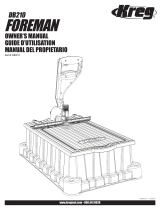 Kreg DB210 Manuel utilisateur
Kreg DB210 Manuel utilisateur
-
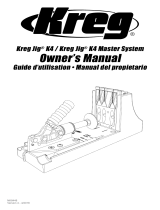 Kreg Jig K4 Manuel utilisateur
Kreg Jig K4 Manuel utilisateur
-
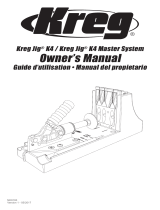 Kreg Jig K4 Manuel utilisateur
Kreg Jig K4 Manuel utilisateur
-
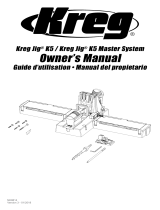 Kreg Jig K5 Master System Manuel utilisateur
Kreg Jig K5 Master System Manuel utilisateur
-
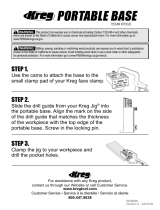 Kreg Portable Base Manuel utilisateur
Kreg Portable Base Manuel utilisateur
-
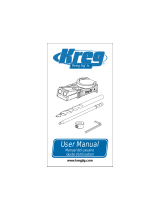 Kreg R3 Manuel utilisateur
Kreg R3 Manuel utilisateur
-
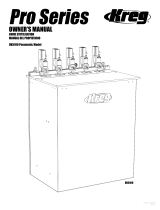 Kreg Panel-Boring Pocket Hole-Machine Manuel utilisateur
Kreg Panel-Boring Pocket Hole-Machine Manuel utilisateur
-
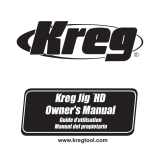 Kreg Jig HD Manuel utilisateur
Kreg Jig HD Manuel utilisateur
-
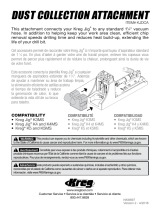 Kreg Dust Collection Attachment Manuel utilisateur
Kreg Dust Collection Attachment Manuel utilisateur
-
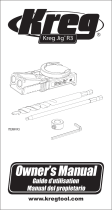 Kreg Jig R3 Manuel utilisateur
Kreg Jig R3 Manuel utilisateur























































